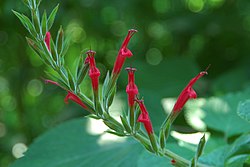Salvia elegans
| Habit | shrub
| |
|---|---|---|
| Height: | ⇕ | 2 ft"ft" can not be assigned to a declared number type with value 2. to 3 ft"ft" can not be assigned to a declared number type with value 3. |
| Lifespan: | ⌛ | perennial |
| Origin: | ✈ | Mexico, Guatemala |
| Bloom: | ❀ | mid spring, late fall, early winter |
| Exposure: | ☼ | sun |
|---|---|---|
| Water: | ◍ | moist, moderate |
| Features: | ✓ | flowers |
| USDA Zones: | 8 to 11 | |
| Sunset Zones: | 8-24, 26-30 | |
| Flower features: | ❀ | red, pink |
|
Salvia > |
elegans > |
Salvia elegans, commonly called Pineapple sage, is a perennial shrub native to oak and pine scrub forests at 6,000-9000 ft. in the highlands of Mexico and Guatemala.[1] It has tubular red flowers and an attractive scent to the leaves that is similar to pineapple. It produces numerous erect leafy stems and flowers in the late autumn. The red flowers are attractive to hummingbirds and butterflies. In a highland temperate forest in central Mexico, pineapple sage was found to be one of the three most-visited species by hummingbirds.[2] Anthesis in Mexico is Aug. in North-European climate it is Dec. - Jan.
In cultivation, Pineapple sage grows to 1.2 - 1.5 m (4-5 ft.), with the roots extending underground to form a large clump. The pale yellow-green leaves are veined, and covered with fine hairs. Six to twelve scarlet flowers grow in whorls, with a long inflorescence that blooms gradually and over a prolonged period of time. With a hard frost, the plant will die down to the ground and grow back the following spring. Pineapple sage was introduced into horticulture about 1870.[1]
Pineapple sage leaves are edible and can be steeped in hot water to make an herbal tea, or used in cool drinks and salads.
Cultivation
Cultivation in North-European climate: Put the plants inside before frost, cut back down to the ground after anthesis (Dec. - Jan.).
Propagation
From softwood cuttings.
Pests and diseases
Varieties
The variety "Honey Melon", which has the same pineapple fragrance in the leaves, blooms early in the summer, rather than in autumn.[1]
Gallery
References
- w:Salvia elegans. Some of the material on this page may be from Wikipedia, under the Creative Commons license.
- Salvia elegans QR Code (Size 50, 100, 200, 500)
External links
- ↑ 1.0 1.1 1.2 Clebsch, Betsy; Carol D. Barner (2003). The New Book of Salvias. Timber Press. pp. 115-117. ISBN 9780881925609. http://books.google.com/books?id=NM0iwB8GrQYC&pg=PA115&dq=%22salvia+elegans%22&as_brr=3&ei=tNRWSeDUOoPKkQTV4umoCg.
- ↑ Lara, Carlos (Mar. 2006). "Temporal dynamics of flower use by hummingbirds in a highland temperate forest in Mexico". Ecoscience 13 (1). http://www.bioone.org/perlserv/?request=get-abstract&doi=10.2980%2F1195-6860(2006)13%5B23%3ATDOFUB%5D2.0.CO%3B2&ct=1.



